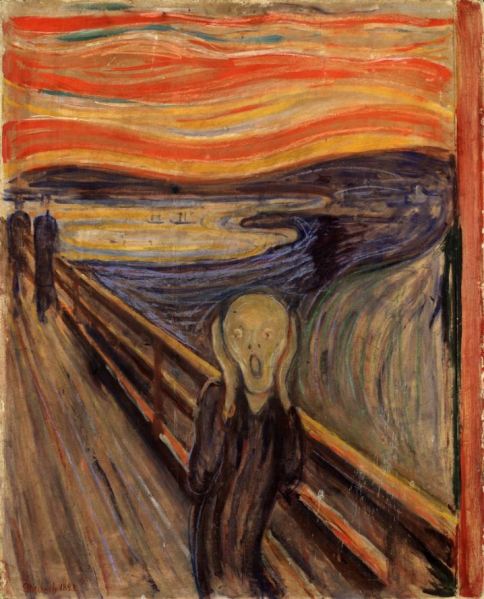Andrea Hope

Edvard Munch is the painter of The Scream, which is one of the most recognisable works in the history of art.
Both a painter and printmaker, Munch grew up in a household periodically beset by life-threatening illnesses and the premature deaths of his mother and sister.
These tragic events left a lifelong impression on the artist, and contributed to his eventual preoccupation with themes of anxiety, emotional suffering, and human vulnerability. (They were all explained by Munch’s father, a Christian fundamentalist, as acts of divine punishment.)
Much of his work depicts life and death scenes, love and terror, and the feeling of loneliness. He intended that these often open-ended themes would function as symbols of universal significance.
His painting style included the use of contrasting lines, blocks of darker intense colour, sombre tones, exaggerated form and semi-abstraction, which all contributed to create an air of mystery.
In 1879, Munch began attending a technical college to study engineering, but left only a year, and in 1881 he enrolled at the Royal School of Art and Design. Here he studied the old masters, attended courses in the painting of nudes, and was instructed for a time by Norway’s leading artist, Christian Krohg.
His early works were influenced by French inspired Realism.
He began a series of new paintings in the mid 1880s which departed from this earlier style. One of these was The Sick Child, which he would finish in 1886. The Sick Child depicted his feelings about the death of his sister nearly nine years earlier. Munch revisited this subject many times until 1925. (His brother, Andreas, also died young in 1895.)
From 1889 (the year his father died) to 1892, Munch lived mainly in France, funded by State scholarships, and embarked on the most productive as well as the most troubled period of his artistic life. While studying in Paris and in Nice in the south of France, he was influenced by the Impressionists’ fascination with light and by the growing Symbolist movement which inspired his symbolic use of colour and simplification of form. He saw the work of Gauguin and Van Gogh, whose Starry Night he paid tribute to in his own painting of the same name thirty years later.
These works had a liberating effect on Munch. “The camera cannot compete with a brush and canvas,” he wrote, “as long as it can’t be used in heaven and hell“.
Munch’s experimentation with different media and techniques was driven by his expressive needs and he explored the different effects he could achieve by reinterpreting the same theme in a different medium. As a printmaker Munch made drypoints, etchings and lithographs in the traditional manner. However, he developed his own unique technique for colour woodcuts.
Despite suffering from mental illness, Munch was spectacularly prolific, creating an astonishing 1,008 paintings, 4,443 drawings and 15,391 prints, as well as woodcuts, etchings, lithographs, lithographic stones, woodcut blocks, copperplates and photographs. (source: http://www.finearts360.com)
It was during the last decade of the 19th Century that he undertook a series of paintings he called the Frieze of Life, encompassing 22 works for a 1902 Berlin exhibition. With paintings bearing such titles as Despair (1892), Melancholy (c.1892– 93), Anxiety (1894), Jealousy (1894–95) and The Scream (also known as The Cry) Munch’s mental state was fully exposed. His style varied greatly in these paintings, depending on which emotion had taken hold of him at the time.
The exhibition was highly successful and Munch became more widely known within the art world. Subsequently, he found brief happiness in a life otherwise coloured by excessive drinking, family misfortune and mental distress. From about 1892 to 1908 Munch spent most of his time between Paris and Berlin.
During a stay in Paris he met a number of Symbolist poets, which resulted in him designing the sets of Ibsen’s Peer Gynt at the Theatre de l’Oeuvre (at the same time that his Frieze of Life was being exhibited at the de l’Art Nouveau). In 1906 he designed the sets for another of Ibsen’s productions, Ghosts.
In 1903-4 he exhibited in Paris where it is likely that he saw early Fauvist painting and may have found inspiration in them. When the Fauves held their own exhibit in 1906, Munch was invited and displayed his works with theirs.
As the 1900s began, his drinking spun out of control. In 1908, hearing voices and suffering from paralysis on one side, he collapsed and finally checked himself into a private sanatorium, where he drank less and improved his mental health.
In the spring of 1909 Munch moved to a country house in Ekely (near Oslo), Norway, where he lived in isolation and began painting landscapes. Munch painted right up to his death, often depicting his deteriorating condition and various physical maladies in his work.
Munch’s work, which showed so much raw emotion, greatly influenced German Expressionism in the early 20th century.
Andrea Hope
2016
This blog is just a short excerpt from my art history e-course, Introduction to Modern European Art which is designed for adult learners and students of art history.
This interactive program covers the period from Romanticism right through to Abstract Art, with sections on the Bauhaus and School of Paris, key Paris exhibitions, both favourite and less well known artists and their work, and information about colour theory and key art terms. Lots of interesting stories, videos and opportunities to undertake exercises throughout the program.
If you’d like to see some of the Australian artwork you’ll find in my gallery, scroll down to the bottom of the page. You’ll also find many French works on paper and beautiful fashion plates from the early 1900s by visiting the gallery.





















